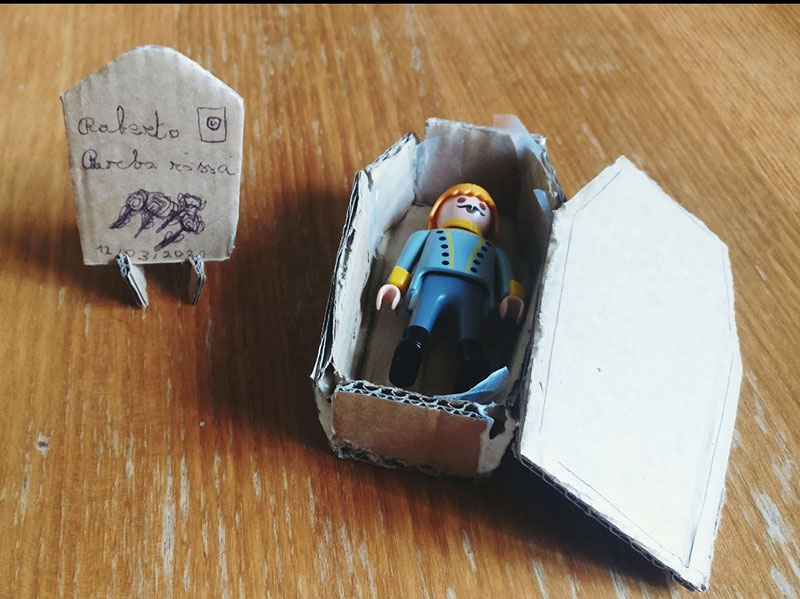The ceremony I want to share in this post is an example of Death Education, or rather, as I prefer to say: becoming familiar with the thought of death and the sense of finiteness. I believe that getting acquainted with the thought of death is crucial in contemporary society, not only because it helps us better understand and cope with death but also because it contributes to reducing anxieties and fears associated with this inevitable aspect of life. Furthermore, it promotes open communication on the topics of grief and death, breaking cultural taboos and fostering greater awareness.
What is Death Education?
Death Education refers to educational programs or approaches that seek to address and understand death in a more open and informed way. These programs may include discussions on cultural, spiritual, emotional, and practical aspects related to death. The goal is also to promote a more comprehensive understanding of this inevitable aspect of life, even among the youngest.
Death Education for children
Death Education for children focuses on educational approaches that help them understand death in an age-appropriate manner. These programs may involve stories, creative activities, and guided discussions to help them explore and cope with their emotions regarding loss and death. The goal is often to provide them with tools to cope with grief in a healthy way and to develop a clearer understanding of this aspect of life.
Death Education to foster dialogue
Moreover, Death Education can contribute to building a culture that respects diverse cultural and spiritual perspectives on death, providing a common ground for dialogue and mutual support. In general, it fosters a more complete and conscious view of life and death.
The secular funeral ceremony for a Playmobil
“Shall we do the funeral ceremony for my Playmobil?” The father raises his head, turns to his seven-year-old son, and, after a moment of silence, says:
“Ah, yes, certainly… Excellent idea. And who would you like to bury?”
“The captain. Yes, my blond Playmobil with the black mustache, the one dressed as a captain.”
“What happened to him?”
“He was sailing with his cargo ship off the coast of Germany, and suddenly, he crashed into a giant rock. The ship started taking on water, and he didn’t want to leave it: he sank with it and its precious cargo.”
“Perfect! So, let’s get to work. Well… to properly celebrate a ceremony, first, we need to prepare the coffin.”
“Is cardboard okay? I found some heavy cardboard from an old box I found in the closet yesterday.”
“Perfect! Cardboard is great!”
Father and son gather scissors, glue, and cardboard and search online for a coffin template. They want to do things properly. Both get to work, and after half an hour of diligent work, they complete the task; a simple, no-frills coffin, but tailor-made for the captain, whom the little one has given an impressive name: Roberto Barbarossa.
Father and son contemplate their work with satisfaction. The child delicately places the captain in the sarcophagus and seals it with small nails.
A moment of silence follows. As it should be.
“And now?” “Now we have to write the text for the farewell ceremony, to tell who Captain Barbarossa was and celebrate his life.”
The child is not very enthusiastic about having to sit down and compose a text. Writing is not his passion, but he understands the need to recount the captain’s life and gets to work. Many interesting details about Captain Barbarossa’s life are added during the text composition: from his youth, he was a sea wolf, his ship was called “Nanà,” and in the crates, he transported nothing less than precious chocolate spreadable cream!
Once the farewell ceremony booklet is neatly prepared, they decide on the location to officiate the ceremony and the burial place: a large vase in the garden.
The music playlist is a fundamental part of the ceremony. They choose a piece titled “Everything a Man Needs.” The very young celebrant reads the funeral farewell he wrote, and at the moment of the final farewell, “Goodbye, Captain,” while the small coffin is placed in the hole dug inside the vase, the music starts.
At the end of the song, a small cypress is planted on the mound of soil covering the coffin, and the child places the tiny cardboard tombstone next to it.
The Playmobil farewell ceremony concludes with a minute of silence.
A “game” celebration to cope with the pain of death
It’s worth noting that this toy ceremony took place a month after the child’s grandfather passed away, during the Covid-19 pandemic. The child, in a way, replaced his grandfather’s funeral, which couldn’t be held due to health restrictions, with a kind of substitute celebration. This became possible because the family openly discussed death and didn’t shy away from the thought. The child then found his own way to process it.
Let’s discuss Death Education together at the 2024 edition of Tanexpo
The 2024 edition of Tanexpo will take place on April 4th, 5th, and 6th of next year, with an entire section dedicated to training and information on funeral-related topics. On Friday, April 5th, I will have the pleasure of conducting a workshop titled: “Non-religious funeral services: new scenarios in society and proposals for telling a life story.” (linkare il titolo a: https://www.tanexpo.com/it/funerale-laico)
Would you like to sign up for my workshop?
Click here: https://www.tanexpo.com/it/funerale-laico




